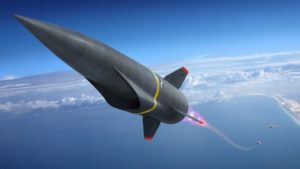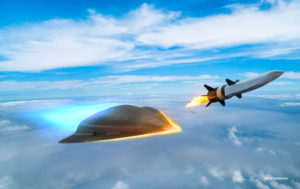A Navy official recently confirmed the service is advancing efforts to arm the three-vessel Zumwalt-class DDG-1000 destroyers with hypersonic weapons, as directed by Congress.
The fiscal year 2021 Defense Authorization Act contained a provision directing the Navy to initiate integrating the Conventional Prompt Strike (CPS) hypersonic weapon on to the DDG-1000-class destroyers by Jan. 1, 2021 (Defense Daily, June 21).

Rear Adm. Paul Schlise, Director of Surface Warfare Division (OPNAV N96), told reporters during a Jan. 8 media call this capability was under discussion previously and “it’s in law now. So we are moving out on that on the studies of the hull form, what’s got to be done to modify it to incorporate that capability potentially down the road.”
Schlise said part of studying adding the CPS capability to DDG-1000 is getting a larger diameter Vertical Launch System (VLS) than the current Mark 41 VLS, which he called a “fleet workhorse” for decades.
“We think a larger diameter round like the CPS round is a part of our future. So the potential here for a future incorporation on DDG-1000 is that we’re pretty excited about to get that larger diameter VLS.”
“Certainly it’s going to be able to extend the range substantially, put a larger set of targets at risk, and the CPS round is still very much a developmental round,” he continued.
Schlise said the different types of potential warheads and targets sets that can be added to the larger VLS “is an open book still” and is likely to be capable of targeting both maritime and land attack threats.
Schlise said as they work on the larger diameter VLS they are incorporating that process into top level requirements in the new future Large Surface Combatant that will succeed the Arleigh Burke-class DDG-51 destroyer.
“We think a version of a larger diameter launcher that can handle around like CPS will absolutely be part of that platform. And so, what we learned from the DDG 1000 integration will be applied going forward as we think about that future large surface combatant.”

Schlise said the Navy had done the initial design work on the larger diameter VLS and is “looking at getting that done in the next one to two years.”
Once that stage is completed, if the Navy has made a decision and has the resources to integrate the VLS, “we would look at what the best timeline is to…back fit that on the DDG-1000 class, coincident with the major yard period, overall periods that are on its schedule.”
While the timeline of the larger diameter VLS and hypersonic weapon is not definite yet, the Navy is moving forward with the congressional direction.
“Frankly both within the Navy and within OSD there’s a lot of excitement over this. So we’re going to move pretty quickly on exploring the art of the possible, the engineering work design work that it would take to incorporate that system into [DDG-1000].”
Last October, National Security Adviser Robert O’Brien said the CPS will first be deployed on new Virginia-class attack submarines, then incorporated to Zumwalt-class destroyers and eventually fielded on all three flights of Arleigh Burke-class destroyers (Defense Daily, Oct. 22, 2020).
In November, Vice Adm. Johnny Wolfe, director of Strategic Systems programs, said the hypersonic weapons would first be deployed on non-nuclear armed Ohio-class guided-missile submarines (SSGNs) by around 2025 before adding them to new Block V Virginia-class attack submarines starting in 2028 (Defense Daily, Nov. 18, 2020).
The Block V vessels will be equipped with the Virginia Payload Module (VPM), increasing the submarine’s capability to 40 total missiles. The VPM is meant to help replace the added capability of the four SSGNS that each carry up to 154 missiles.
The CPS is first expected to be deployed to the Army around 2023 before being fielded by the Navy two years later.